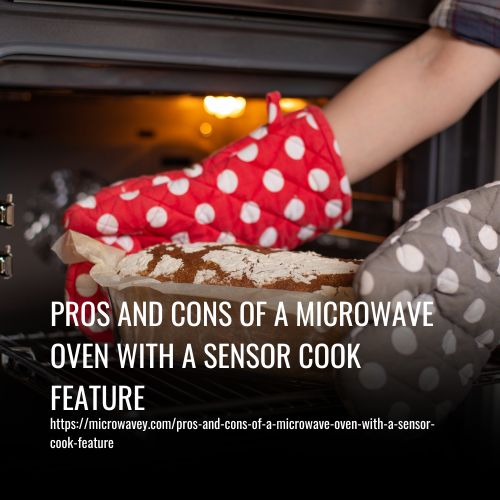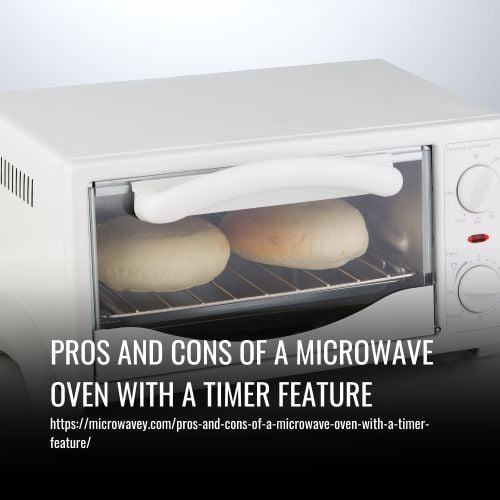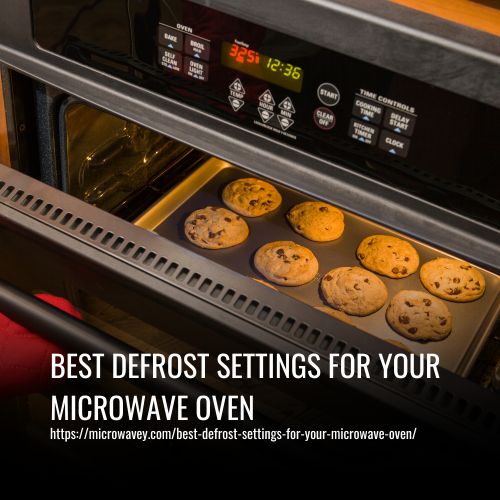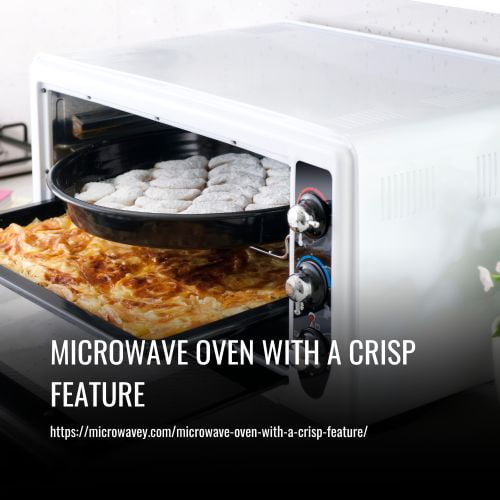Pros And Cons Of A Microwave Oven With A Sensor Cook Feature
Sensor cook microwaves use advanced technology to detect the moisture levels in your food and adjust the cooking time and power levels accordingly, promising evenly cooked dishes with just a touch of a button. However, like any new technology, there are both pros and cons to consider before investing in a microwave oven with a sensor cook feature.
Pros
- Convenience
- Eliminates Guesswork
- Improved Taste and Texture
Cons
- Cost
- Limited Control
- Not Suitable for All Foods

What Are The Pros of Microwave Sensor Cooking
1. Convenience
One of the main benefits of microwave sensor cooking is the convenience it offers. With sensor cooking, you can simply place your food in the microwave, press a button, and let the sensor technology do the work for you. This is perfect for busy individuals who want a quick and easy way to prepare their meals.
2. Eliminates Guesswork
Another advantage of sensor cooking is that it eliminates the need for guesswork when it comes to cooking times. The sensor technology automatically detects the level of moisture in the food and adjusts the cooking time accordingly. This means you don’t have to constantly monitor your food or worry about it being under or overcooked.
3. Improved Taste and Texture
By cooking food evenly and preventing it from being under or overcooked, sensor cooking can result in improved taste and texture. When food is cooked properly, it retains its natural flavors and textures, making for a more enjoyable dining experience. This is especially important for those who are particular about the quality of their food.
What Is The Cons of Microwave Sensor Cooking
1. Cost
One of the main disadvantages of using a sensor cooking microwave is that they tend to be more expensive than traditional microwaves. This may not be feasible for individuals on a tight budget, as the additional cost can be a barrier to purchasing this type of appliance. However, for those who prioritize convenience and precision in cooking, the extra cost may be justified.
2. Limited Control
Sensor cooking microwaves offer a high level of automation and precision in cooking, but some users may find that they prefer more control over the cooking process. With sensor technology, the microwave determines when the food is done, which may not align with individual preferences or desired levels of doneness. This lack of control can be a drawback for those who prefer to have more say in how their food is cooked.
3. Not Suitable for All Foods
While sensor cooking microwaves are versatile and can cook a wide range of dishes, they may not be suitable for certain types of foods that require browning or crisping. Traditional ovens or stovetops may be better suited for dishes that need to be cooked to a specific texture or consistency. In these cases, a sensor cooking microwave may not be the best option for achieving the desired results.
Factors To Consider When Choosing A Sensor Cooking Microwave
1. Size and Capacity
When choosing a sensor cooking microwave, consider the size and capacity that will best suit your needs. If you have a larger family or frequently cook larger portions, opt for a microwave with a higher capacity.
2. Power and Wattage
The power and wattage of the microwave will impact its cooking efficiency. Higher wattage microwaves will cook food faster, but also tend to be more expensive. Consider your cooking needs and budget when selecting the appropriate power level.
3. Price and Budget
Set a budget for your sensor cooking microwave and compare prices to find the best option within your price range. Keep in mind that higher-end models with more features may come at a higher cost.
4. Additional Features and Functionalities
Look for sensor cooking microwaves with additional features that may be useful to you, such as defrosting, grilling, or convection cooking. Consider how you plan to use the microwave and choose a model with the necessary functionalities.
5. Brand and Reputation
Choose a reputable brand known for quality and reliability when selecting a sensor cooking microwave. Research customer reviews and ratings to ensure you are purchasing a durable and well-performing appliance.
Tips For Using A Sensor Cooking Microwave
Tips for Getting the Most Out of Your Sensor Cooking Microwave
1. Use the Correct Dishware
Ensure that you are using microwave-safe dishes and avoid using metal or aluminum foil as they can interfere with the sensors’ ability to detect heat and moisture. Using the right dishware will help your food cook evenly.
2. Follow the Instructions
Different brands and models of sensor cooking microwaves may have slightly different instructions and recommended settings. It is important to read the manual and follow the manufacturer’s recommendations for the best results.
3. Avoid Overloading the Microwave
Do not overload the microwave as it can make it difficult for the sensors to work properly. Follow the recommended guidelines for the maximum amount of food that can be cooked at once to ensure even and accurate cooking.
By following these tips, you can make the most out of your sensor cooking microwave and enjoy perfectly cooked meals every time.
Maintenance And Care For Sensor Cooking Microwaves
1. Regular cleaning
It is important to regularly clean both the interior and exterior of your sensor cooking microwave to prevent the buildup of dirt and grime. Use a damp cloth or sponge to wipe down the surfaces and remove any food particles or spills.
2. Avoid harsh chemicals
When cleaning your microwave, avoid using abrasive cleaners or harsh chemicals as they can damage the sensors and other components. Stick to mild soap and water or a vinegar solution for cleaning.
3. Check for issues
Keep an eye out for any issues with your microwave such as uneven cooking, unusual noises, or error messages. Refer to the manual for troubleshooting tips or contact the manufacturer for assistance.
4. Replace when necessary
If your sensor cooking microwave is showing signs of wear and tear, or if it is no longer functioning properly, it may be time to consider replacing it. Microwaves typically have a lifespan of around 10 years, so be mindful of how old your appliance is.
FAQs
When it comes to the difference between a microwave oven with a sensor cook feature and a regular microwave oven, there’s no doubt that the former is more desirable. As an expert in this field, I can tell you that these types of microwaves are far more energy efficient than their counterparts. Plus, they provide users with optimum portion sizing for whatever dish they’re cooking up. With its sensors detecting moisture levels within food items and automatically adjusting time and power settings accordingly, you’ll get perfectly cooked meals every single time!
Cooking with a microwave oven featuring a sensor cook feature is incredibly time-saving. This type of microwave niftily adjusts the cooking time depending on the type and size of the food being cooked, so you don’t have to guess or adjust it yourself. With this in mind, it typically takes around 3 minutes or less for most foods to be ready! It’s great news if you’re looking to get dinner on the table quickly – plus there are lots more benefits too.
Most microwave ovens with a sensor cook feature don’t require any special installation, and won’t add to your energy bill. In fact, many of these models are designed for maximum energy efficiency – some using up to 70% less energy than traditional microwaves! While the cost of professional installation can be expensive, it’s typically not necessary when you opt for one of these more technologically advanced units. As an expert on microwave ovens with sensor cook features, I recommend considering the energy savings versus the potential installation costs before making your decision.
Cleaning and maintaining your microwave oven with a sensor cook feature is important for ensuring its energy efficiency. The filter of such an oven should be replaced every three to four months, depending on how much you use it. If you’re using the appliance frequently, then replacing the filter more often would be beneficial in order to maintain cleanliness and prevent any dust or debris from clogging up the system – which can lead to decreased performance and higher energy costs. As an expert tip, I suggest inspecting the filter each month so that you know when it’s time to replace it!
Operating a microwave oven with a sensor cook feature is as easy as pie! With just the simple press of a button, you can easily adjust the power usage and operating cost to your desired level. As an expert in microwave ovens, I can safely say that there aren’t many models out there which are simpler to use than one equipped with a sensor cook feature. It’s almost like it has eyes and ears – it knows exactly what type of food you’re heating up and adjusts accordingly!
Conclusion
In conclusion, a microwave oven with a sensor cook feature can be a convenient and time-saving appliance to have in your kitchen. While there are some drawbacks, such as the potential for overcooking or inconsistent results, the pros definitely outweigh the cons.
With the ability to automatically adjust cooking times and power levels, a sensor cook feature can help you achieve perfectly cooked meals with minimal effort. So go ahead, embrace the future of cooking technology and make your life in the kitchen a whole lot easier!






